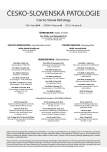The Application of X-ray Imaging in Forensic Medicine
Authors:
Štěpánka Kučerová 1; Miroslav Šafr 1; Michaela Ublová 1; Petra Urbanová 2; Petr Hejna 1
Authors‘ workplace:
Ústav soudního lékařství LF UK a FN, Sokolská 581, 500 05 Hradec Králové
1; Ústav antropologie PřF MU, Kotlářská 2, 611 37 Brno
2
Published in:
Soud Lék., 59, 2014, No. 3, p. 34-38
Category:
Original Article
Overview
X-ray is the most common, basic and essential imaging method used in forensic medicine. It serves to display and localize the foreign objects in the body and helps to detect various traumatic and pathological changes. X-ray imaging is valuable in anthropological assessment of an individual. X-ray allows non-invasive evaluation of important findings before the autopsy and thus selection of the optimal strategy for dissection. Basic indications for postmortem X-ray imaging in forensic medicine include gunshot and explosive fatalities (identification and localization of projectiles or other components of ammunition, visualization of secondary missiles), sharp force injuries (air embolism, identification of the weapon) and motor vehicle related deaths. The method is also helpful for complex injury evaluation in abused victims or in persons where abuse is suspected. Finally, X-ray imaging still remains the gold standard method for identification of unknown deceased. With time modern imaging methods, especially computed tomography and magnetic resonance imaging, are more and more applied in forensic medicine. Their application extends possibilities of the visualization the bony structures toward a more detailed imaging of soft tissues and internal organs. The application of modern imaging methods in postmortem body investigation is known as digital or virtual autopsy. At present digital postmortem imaging is considered as a bloodless alternative to the conventional autopsy.
Keywords:
radiological methods – forensic medicine – X-ray imaging – autopsy – virtopsy
Sources
1. Brogdon BG, Lichtenstein JE. Chapter 2: Forensic radiology in historical perspective. In: Brogdon BG. Forensic radiology. Boca Raton: CRC Press; 1998: 18-32.
2. Eckert WG, Garland N. The history of the forensic applications in radiology. Am J Forensic Med Pathol 1984; 5: 53-56.
3. Šafr M, Hejna P. Střelná poranění. Galén: Praha; 2010: 203-207.
4. Farrugia A, Raul JS, Geraut A, et al. Destabilization and intracranial fragmentation of a full metal jacket bullet. J Forensic Leg Med 2009; 16: 400-402.
5. Jones AM. An unusual atypical gunshot wound. A coin as an intermediate target. Am J Forensic Med Pathol 1987; 8: 338-341.
6. Adelson L. Bullet embolism with radiologic documentation. A case report. Am J Forensic Med Pathol 1984; 5: 253-256.
7. Glass JM, Zaki SA, Rivers RL. Intracranial missile emboli. J Forensic Sci 1980; 25: 302-303.
8. Guileyardo JM, Cooper RE, Porter BE, McCorkle JL. Renal artery bullet embolism. Am J Forensic Med Pathol 1992; 13: 288-289.
9. Wilson AJ. Gunshot injuries: what does a radiologist need to know? Radiographics 1999; 19: 1358-1368.
10. Zátopková L, Hejna P. Fatal suicidial crossbow injury-the ability to act. J Forensic Sci 2011; 6: 537-540.
11. Pollak S, Ropohl D, Bohnert M. Pellet embolization to the right atrium following double shotgun injury. For Sci Int 1999; 99: 61-69.
12. Hain JR. Fatal arrow wounds. J Forensic Sci 1989; 34: 691-693.
13. Hejna P, Šafr M, Zátopková L, Straka L. Circular saw-associated fatality mimicking gunshot injury. J Forensic Sci 2013; 58: 267-269.
14. Eren B, Türkmen N, Toprak Ergönen A, Gündogmus UN. Cranial injury caused by penetrating non-missile foreign body: an autopsy case. Soud Lek 2012; 57: 62-63.
15. Pascual JM, Navas M, Carrasco R. Penetrating ballistic-like frontal brain injury caused by a metallic rod. Acta Neurochir 2009; 151: 689-691.
16. Smith ME, Zumwalt R. Occupational deaths due to penetrating chest injuries from sledgehammer fragments: two case reports and review of the literature. Am J Forensic Med Pathol 2004; 25: 71-73.
17. Kahana T, Hiss J. Forensic radiology. Br J Radiol 1999; 72: 129-133.
18. Brogdon BG. Child abuse. In: Forensic radiology. Boca Raton: CRC Press; 1998: 281-314.
19. Charlier P, Chaillot PF, Watier L, et al. Is post-mortem ultrasonography a useful tool for forensic purposes? Med Sci Law 2013; 53: 227-234.
20. Thali MJ, Jackowski C, Oesterhelweg L, Ross SG, Dirnhofer R. VIRTOPSY–the Swiss virtual autopsy approach. Legal Medicine 2007; 9: 100-104.
21. Donchin Y, Rivkind AI, Bar-Ziv J, Hiss J, Almong J, Drescher M. Utility of postmortem computed tomography in trauma victims. J Trauma 1994; 37: 552-556.
22. Dirnhofer R, Jackowski C, Vock P, Potter K, Thali MJ. VIRTOPSY: minimally invasive, imaging-guided virtual autopsy. Radiographics 2006; 26: 1305-1333.
23. Thali MJ, Yen K, Schweitzer J, et al. Virtopsy, a new imaging horizon in forensic pathology: virtual autopsy by postmortem multislice computed tomography (MSCT) and magnetic resonance imaging (MRI)-a feasibility study. J Forensic Sci 2003, 48: 386-403.
24. Levy AD, Abbott RM, Mallak CT, et al. Virtual autopsy: preliminary experience in high-velocity gunshot wound victims. Radiology 2006; 240: 522-528.
Labels
Anatomical pathology Forensic medical examiner ToxicologyArticle was published in
Forensic Medicine

2014 Issue 3
Most read in this issue
- The Application of X-ray Imaging in Forensic Medicine
- Injuries associated with cardiopulmonary resuscitation
- A questionable bruise
- A case of arrhythmogenic right ventricular cardiomyopathy (ARVC/D) in which tenascin C immunostaining made the assessment of myocardial remodeling possible
